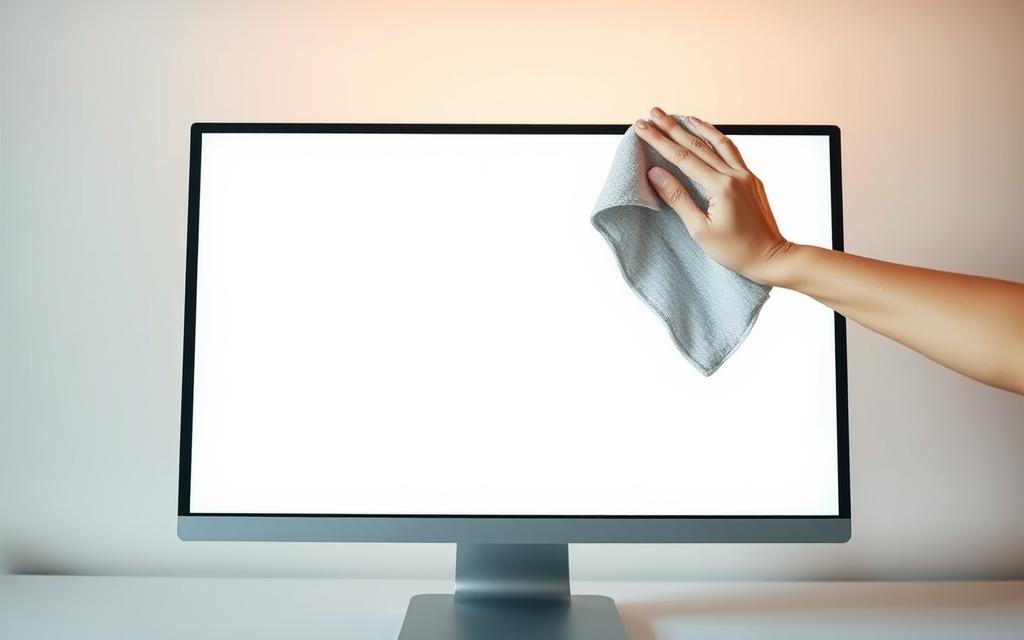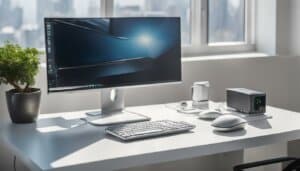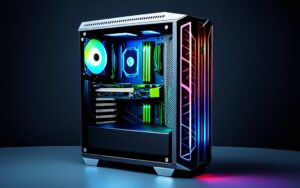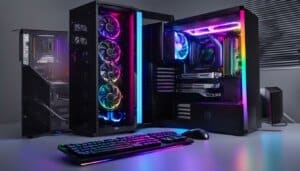Table of Contents
A computer screen can accumulate dust, fingerprints, and smudges over time, affecting visibility and work efficiency. Proper cleaning techniques are essential to maintain screen clarity without causing damage to sensitive display surfaces.
Different screen types, such as LCD, LED, and OLED, require specific cleaning approaches to avoid potential damage. Regular maintenance not only improves visibility but also extends the lifespan of your computer. Understanding what products to avoid is just as important as knowing the right cleaning methods to use.
This comprehensive guide will walk you through the best practices for cleaning your computer screen safely and effectively, ensuring your screen remains pristine and functional.
Understanding Computer Screen Types and Their Cleaning Requirements
Computer screens come in various types, each requiring specific cleaning approaches to maintain their quality. The type of screen you have can significantly impact how you should clean it, as different materials and technologies are used in their construction.
Different Types of Computer Screens
There are several types of computer screens, including LCD (Liquid Crystal Display), LED (Light Emitting Diode), and OLED (Organic Light Emitting Diode) screens. LCD screens are the most common and feature a delicate surface that can be easily damaged by harsh chemicals or excessive pressure. LED screens, a type of LCD that uses LED backlighting, offer better energy efficiency but require similar gentle cleaning approaches. OLED screens provide superior image quality but have an even more sensitive surface that demands extra care during cleaning.
Why Regular Cleaning is Important
Regular cleaning of your computer screen is crucial for maintaining its performance and longevity. Dust buildup can affect screen performance and potentially cause overheating in some computer models. Accumulated fingerprints and oils from regular use not only obstruct visibility but can eventually degrade screen coatings if left untreated. Using a microfiber cloth can help remove dust and other particles without scratching the screen.
Understanding your specific screen type helps determine the appropriate cleaning method and frequency to maintain optimal display quality. Regular cleaning prevents dust buildup and reduces the risk of damage to the screen’s coating or underlying technology.
What NOT to Use When Cleaning Your Computer Screen
Understanding what not to use when cleaning your computer screen is crucial for maintaining its quality. Certain cleaning products and methods can cause irreversible damage, such as discoloration or screen malfunction.
Harmful Cleaning Products to Avoid
Some cleaning products are particularly harmful to computer screens. For instance, cleaners containing ammonia or acetone should be avoided, as they can damage screen coatings. Many window cleaners, including certain types of Windex, contain ammonium hydroxide, a solution made of ammonia and water. The Environmental Protection Agency classifies ammonia as an “extremely hazardous substance,” especially in high concentrations.
- Window cleaners containing ammonia can permanently damage screen coatings.
- Household cleaners with harsh chemicals like acetone or hydrogen peroxide can strip protective coatings.
- Abrasive cleaning tools can scratch the screen surface.
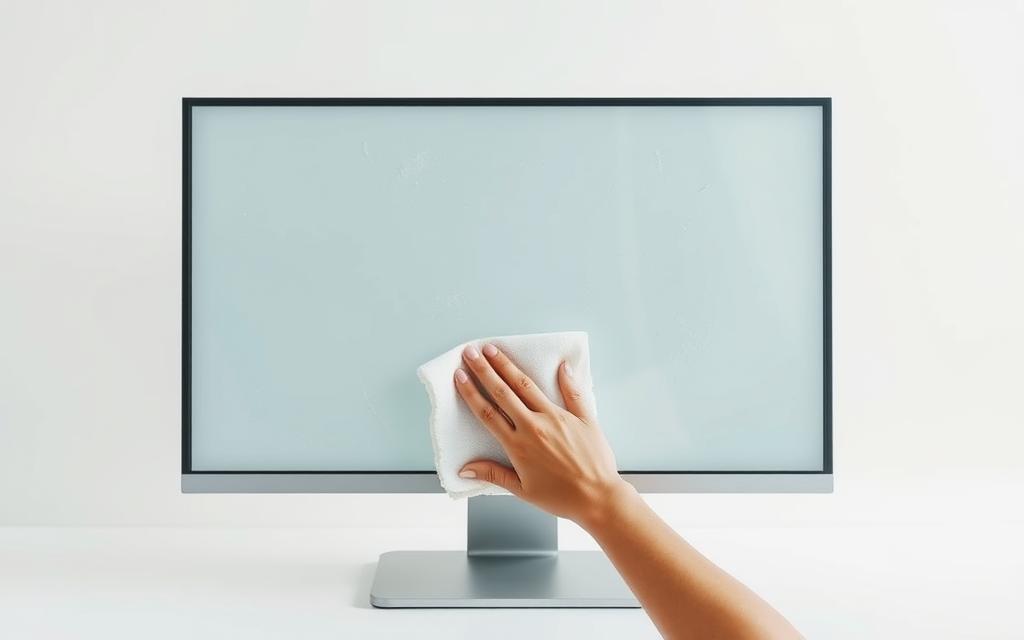
Common Cleaning Mistakes That Can Damage Your Screen
Apart from using the wrong cleaning products, there are several common mistakes people make when cleaning their computer screens. These include using paper towels or tissues, which can create micro-scratches due to their abrasive texture.
- Spraying liquids directly onto the screen can lead to moisture seeping into the edges and causing electrical damage.
- Using tap water, which contains minerals that can leave residue and streaks on the screen.
- Applying excessive pressure when cleaning can damage internal components, causing dead pixels or distorted areas.
By avoiding these common mistakes and harmful products, you can significantly extend the lifespan of your computer screen.
Essential Supplies for How to Clean Computer Screen Properly
Before you start cleaning your computer screen, it’s crucial to gather the necessary supplies to do the job right. Cleaning your screen is not just about wiping it down; it’s about using the right materials to avoid damage and ensure a clear, streak-free finish.
Recommended Cleaning Solutions
When it comes to cleaning your computer screen, the solution is just as important as the cloth you use. Distilled water is a safe choice as it doesn’t contain minerals that could leave residue on your screen. For tougher grime, a specialized electronic screen cleaner is recommended. These cleaners are formulated to be gentle on screen coatings while effectively removing dirt. In some cases, a 70% isopropyl alcohol solution diluted with distilled water can be used, but this should be applied sparingly and never directly to the screen.
- Distilled water is the safest liquid cleaning agent.
- Specialized electronic screen cleaners are effective and gentle.
- A 70% isopropyl alcohol solution can be used for some screen types.
The Right Cloth for the Job: Microfiber vs. Others
The microfiber cloth is the gold standard for cleaning screens due to its ultra-fine fibers that trap dust and oils without scratching the surface. A dry microfiber cloth is often sufficient for light dust, while a slightly dampened cloth works better for stubborn smudges. It’s advisable to keep multiple clean microfiber cloths on hand to prevent spreading dirt across the screen.
- Microfiber cloths are ideal for screen cleaning.
- A dry microfiber cloth is best for light dust.
- Use a slightly dampened microfiber cloth for tougher smudges.
Step-by-Step Guide to Clean Your Computer Screen
Cleaning your computer screen is a straightforward process if you follow the right steps. A clean screen not only enhances your viewing experience but also helps in maintaining the longevity of your monitor.
Preparation Steps Before Cleaning
Before you start cleaning your computer screen, it’s essential to prepare it properly. Turn off your desktop monitor or power down your laptop to prevent any electrical damage and to make smudges more visible. Then, position your monitor toward a light source to better identify dirty areas that need attention.
- Power down your computer and unplug it to prevent electrical damage.
- Position your monitor toward a light source to identify dirty areas.
- Remove loose dust first with a dry microfiber cloth using gentle, sweeping motions.
The Proper Cleaning Technique
For a deeper clean, you’ll need a microfiber cloth and a suitable cleaning solution. Lightly dampen a clean microfiber cloth with distilled water or an appropriate screen cleaner. The cloth should be just barely moist, not wet.
Apply the damp cloth to the screen using gentle, overlapping Z-pattern strokes, starting from the top and working down to prevent streaking. Avoid applying pressure, as this can damage the display; let the cloth and cleaning solution do the work.
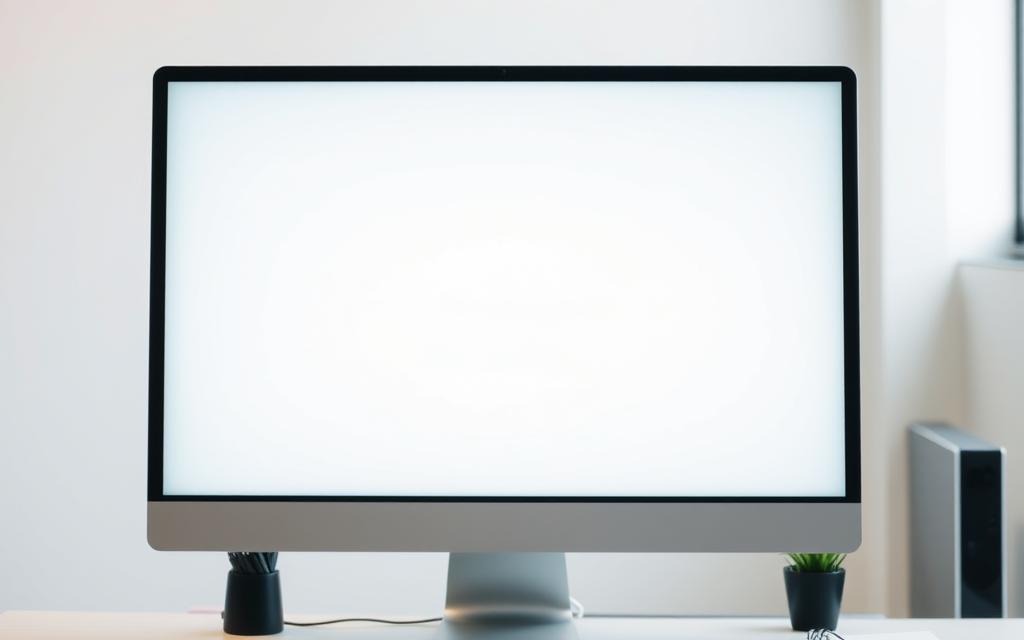
Drying and Final Touches
After cleaning with a damp cloth, use a separate dry microfiber cloth to buff the screen gently and remove any remaining moisture. Allow the monitor screen to completely dry before turning the power back on to prevent potential electrical issues. Finally, inspect the screen from different angles to identify any missed spots or streaks that may need additional attention.
- Use a dry microfiber cloth to buff the screen and remove moisture.
- Allow the screen to dry completely before turning it back on.
- Inspect the screen from different angles to ensure it’s clean.
Maintaining a Clean Computer Screen
Maintaining a clean computer screen is crucial for optimal viewing and longevity. To achieve this, it’s essential to follow a fewsimple tipsthat enhance your viewing experience and prolong the life of your monitor.
Preventative Measures to Reduce Dirt and Fingerprints
To minimize dirt and fingerprints on your screen, wash your hands before using your computer. Positioning your computer away from high-traffic areas can also reduce dust accumulation. Consider using a screen protector for added defense against fingerprints and scratches.
Recommended Cleaning Schedule
Establish a regular cleaning schedule based on your environment. For dusty areas or shared workspaces, clean your screen weekly. For personal computers in clean environments, bi-weekly cleaning is sufficient. Keep cleaning supplies accessible to encourage regular maintenance.
Address smudges and fingerprints promptly, as oils can be difficult to remove after they’ve set. If streaks appear after cleaning, use dry sections of your microfiber cloth to buff them away. Never apply pressure when cleaning monitors, as this can damage internal components.
FAQ
What is the best way to clean a stubborn stain on my monitor?
For tough stains, dampen a microfiber cloth with distilled water, but make sure it’s not soaking wet. Gently wipe the stain, and then dry the area with a dry section of the cloth.
Can I use paper towels to wipe my screen?
No, it’s not recommended to use paper towels as they can leave behind lint and potentially scratch the screen. Instead, use a microfiber cloth, which is gentle and effective.
Is it safe to use ammonia or other harsh chemicals to clean my computer screen?
No, ammonia and other harsh chemicals can damage the screen’s coating or harm the display. Stick to gentle cleaning solutions specifically designed for screens or use distilled water with a microfiber cloth.
How often should I clean my monitor screen?
It’s a good idea to clean your monitor screen regularly, ideally once a week, to remove dust, fingerprints, and other marks that can affect visibility.
Can I use tap water to clean my screen?
While tap water is generally okay, it’s recommended to use distilled water to avoid any mineral deposits that might be present in tap water, which can leave streaks or spots on your screen.
What type of cloth is best for cleaning computer screens?
A microfiber cloth is the best choice for cleaning computer screens because it’s soft, gentle, and effective at removing dust and other marks without leaving streaks or residue.


